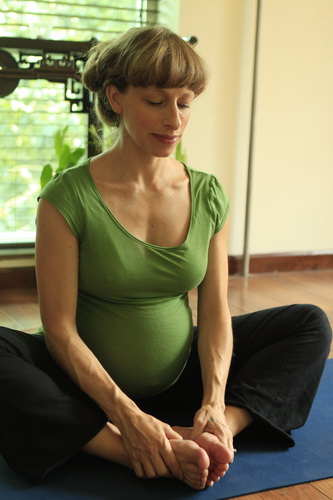
Nature. We are surrounded by it. We are comforted by products that have this printed on it. We long for it from our cubicles and offices. Yet we often circumvent its obvious “nature,” because we don’t trust or cannot hear what our bodies are saying.
Pregnancy is one of these natural amazing tasks our bodies perform. I’ve been walking around with this little person developing in my belly feeling quite chuffed, like my husband and I did something stupendous. We did, but it’s something that most can do.
The odds of a sperm getting through to an egg, for example (Google it!), but it happens often. Against the odds, we continue to propagate.
Recently, I took part in a prenatal yoga teacher training, and as the most pregnant participant (31 weeks), I was blown away by the physiology of pregnancy and what my body had been doing and will be expected to do when it’s time to give birth.
Often, the birthing process is over-complicated, depending on our cultural beliefs, when the most realistic, holistic approach is allowing the body to naturally do its thing. The myths of pregnancy and childbirth are many, and are regarded as truths, which is weird, considering how common birth is.
A nursing trainer from Fuchan Women’s Hospital in Beijing came to speak with us at the training. She explained the current C-section rate in China’s 46 percent (WHO quotes Beijing at 51 percent). Up significantly from 1970 when it was 5 percent. C-section (paofu chan) in China is considered modern and practical (ta shi). How convenient that the family can choose through careful calculations of fengshui the right day for their baobao to be born. How omniscient to be able to transcend fate.
Likewise, the expecting mother is frightened by everyone’s mention of how painful childbirth is. The family is desperate to help her avoid it. Understandable; we don’t want our loved ones to suffer unnecessarily … but ouch, the word “c-section” really doesn’t really implicate “pain,” but as far as I’m concerned, slicing thru layers of CORE muscles and fascia does not sound like a walk in the park (unless it’s emergent).
In the eyes of Chinese culture, the choice of C-section means everybody wins; the hospital makes more money (2x the price of a vaginal birth), the doctor can schedule a time for the baby to be “born,” the woman gets a “pain-free” birth and the parents get their grandchild on a fortunately chosen day.
By interfering with what’s natural, the baby doesn’t get the vaginal “squeeze” which stimulates the baby’s meridians, lungs, head. The mother is cut right below her core chakra or dantian, which in Chinese medicine messes with the meridians, as well as makes movement very painful (we use our core muscles for A LOT). Depending on the age of the mother, instead of 30-40 days recovery from a natural birth, it can take up to a year to fully heal. Yowch.
It’s not much less in the US at 32 percent (2010). It is sited that physician liability is a main reason (lawsuit culture).
The good news is that Beijing/China is working on cutting their C-section rates down (yes, pun intended) through educating the huge population.
I just wish I could have taken that nursing educator home to visit my in-laws. She didn’t just speak about C-section, but hashed into many Chinese myths.
For example:
- Myth 1: You’re eating for 2. Truth: You are nourishing yourself, and your baby. Eat nutritiously.
- Myth 2: A fatter, bigger baby is better. Truth: The birth canal accommodates to a certain size. Fatter baby = difficult birth.
- Myth 3: Don’t do anything while you’re pregnant. Stop moving. Truth: Appropriate exercise and movement for a pregnant woman is good. By not moving at all, muscle emaciates, and birthing is more difficult.
Myths exist in any culture. After finishing the prenatal yoga training, I know the most important learning for anyone is self-awareness. It’s good to trust that your body really can handle it. Now, we have capable healthcare that can assist in case of emergency. The more tuned into yourself, the easier it is to question recommendations of others. I’ve found that during pregnancy, this is extremely important, as it comes in high frequency and often without invitation!
Photo courtesy of Jess Meider



